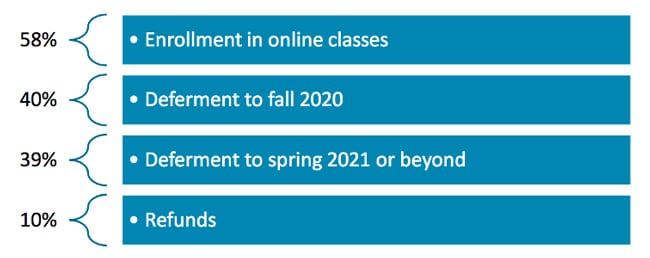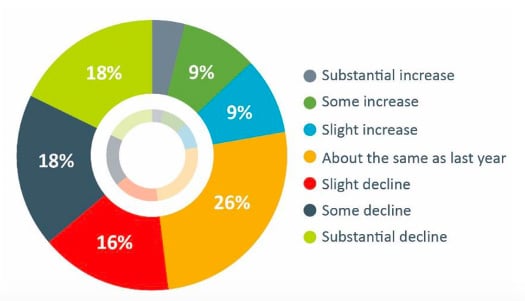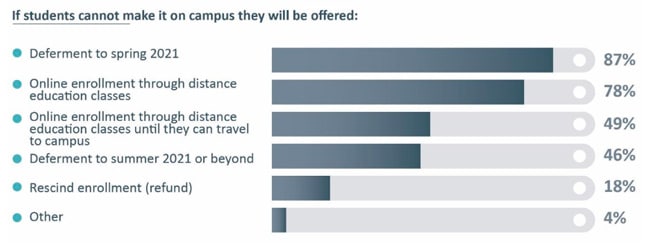Survey: Most US colleges will adopt a hybrid learning model for fall 2020
- US campuses will look and feel very different this fall as colleges adapt course delivery to enhance student and faculty safety during the COVID-19 crisis
- A new IIE survey finds that nearly 9 in 10 US higher education institutions are planning for a hybrid model of instruction
- Many institutions enrolling international students report that applications are down but that intentions among admitted students to enrol in fall 2020 are higher than intentions to defer till spring 2021
A new survey conducted by the Institute of International Education (IIE) indicates that most students enrolled at US colleges and universities this fall will be learning according to a hybrid model combining in-person and virtual instruction. Fully 92% of 520 responding US higher education institutions – collectively enrolling more than 500,000 students – participating in the study said they will be introducing a new instructional approach compared with previous semesters, and of these institutions, 87% will be offering a hybrid model.
The survey, entitled “New Realities for Global Student Mobility in Summer and Fall 2020”, was fielded from 9 July 9–24 July, 2020, and is the third in a series of surveys conducted by IIE to assess the impact of COVID-19 on the higher education sector in the US.
Practice in the summer
The survey found that the vast majority of institutions have adopted a novel learning approach dictated by COVID-19 safety requirements and travel restrictions during the current summer season, a switch that is preparing them for the fall semester beginning in September. Nearly three-quarters (73%) of responding institutions moved to online-only course delivery this summer. Another 20% have been using a hybrid model to deliver course content to their students.
As for their international students, colleges mainly reported strong retention from spring to summer of 2020. Just over 300 institutions of the 530 participating in the survey hosted a combined total of more than 40,000 international students on their campus as of summer 2020. They reported that most of the international students enrolled on-campus in the spring had continued their courses in the summer as well.
Another 7,300 new or continuing students enrolled for the summer semester were not able to come to the US because of COVID-19. For these students, the institutions offered a range of options, detailed in the following chart.

The survey report notes that US institutions’ approach to managing international enrolments has evolved since the early months of the coronavirus crisis:
“Earlier in the COVID-19 pandemic, colleges and universities were more likely to offer a leave of absence, deferment, or refunds to students. As institutions have developed virtual courses for all students, more colleges and universities have pivoted to offering virtual enrolment.”
Fall 2020 is all about hybrid learning
Only 5% of reporting institutions said they plan to offer exclusively in-person learning this fall, representing a sea change in the way students were learning in the US compared to September 2019. In fact, fully 92% of institutions said that their instructional plan for fall 2020 is completely new, different than anything they’ve ever done before.
For the vast majority, the way forward – at least for now – is hybrid learning, with 87% of institutions planning to take this approach in the fall of 2020. Only 5% planned to offer virtual-only learning.
As for what hybrid learning will actually look like, it varies. Some of the institution-wide approaches include:
- “Limiting in-person instruction to a certain percentage (e.g., 20% of classes will be held in-person);
- Restricting in-person instruction to class size (e.g., maximum eight students or fewer for in-person instruction);
- Offering in-person instruction until a specific date, such as Thanksgiving, after which instruction will be online;
- Only allowing in-person instruction for certain types of classes, such as labs or practicums.”
On-campus learning will be very different
Student and faculty safety is of the utmost concern as US institutions head into the fall semester. High numbers of institutions say they will adopt the following safety measures:
- Face coverings for all on campus (94%)
- Restrictions on on-campus events (89%)
- Restrictions on social areas on campus (86%)
- Regular symptom monitoring for all on campus (78%)
- Reduced class sizes (77%)
How will the fall look for international students?
Over 9 in 10 institutions said that they believe most of their current international students will stay enrolled through fall 2020. But the majority anticipate fewer new international students enrolling in their programmes for 2020/21 based on applications so far, as shown in the following chart.

In optimistic news, the majority of international students who have been admitted to US institutions for the fall semester intend to enrol in the fall. According to data from a survey question answered by 286 institutions, fewer than 5,000 of international students admitted have deferred to spring 2021 or beyond, compared with 57,555 international students who accepted enrolment in fall 2020.
If international students can’t make it to the US for their courses, US colleges and universities primarily intend to offer them a deferment to spring 2021 or online enrolment through virtual classes.

Flexibility is key
Dr Mirka Martel, head of Research, Evaluation and Learning at IIE, notes that the survey findings suggest an unprecedented capacity for adaptation among US institutions as well as a continuing emphasis on excellence – albeit amidst an intensely challenging time for the US higher education sector.
“With the fall 2020 semester quickly approaching, US higher education institutions are adapting their campuses and coursework for all students given the COVID-19 environment. Our analysis indicates that while flexibility to fast-changing circumstances will be critical, institutions are prepared to enrol students in the coming semester and provide the level of academic excellence that makes the US a top destination for international students.”
For additional background, please see:















